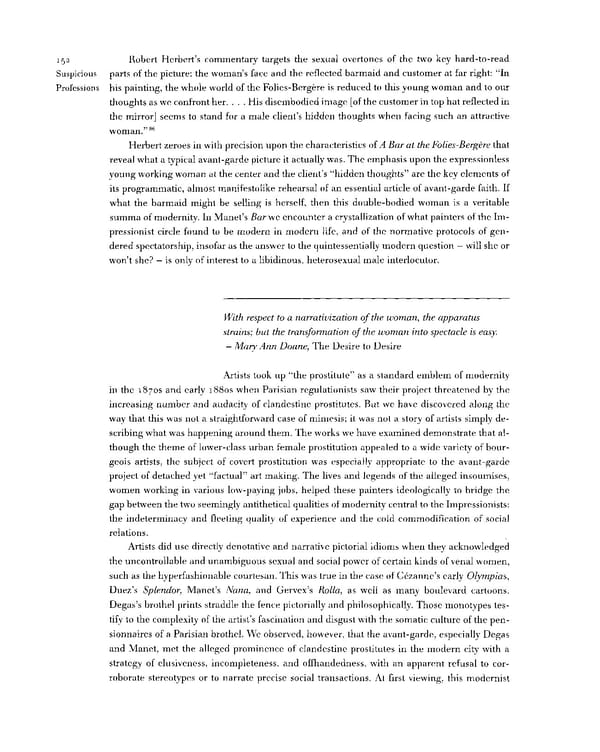2 Robert Herbert's commentary targets the sexual overtones of the two key hard-to-read !5 Suspicious parts of the picture: the woman's face and the reflected barmaid and customer at far right: "In Professions his painting, the whole world of the Folies-Bergere is reduced to this young woman and to our thoughts as we confront her. . . . His disembodied image [of the customer in top hat reflected in the mirror] seems to stand for a male client's hidden thoughts when facing such an attractive 86 woman." Herbert zeroes in with precision upon the characteristics of A Bar at the Folies-Bergere that reveal what a typical avant-garde picture it actually was. The emphasis upon the expressionless young working woman at the center and the client's "hidden thoughts" are the key elements of its programmatic, almost manifestolike rehearsal of an essential article of avant-garde faith. If what the barmaid might be selling is herself, then this double-bodied woman is a veritable summa of modernity. In Manet's Bar we encounter a crystallization of what painters of the Im- pressionist circle found to be modern in modern life, and of the normative protocols of gen- dered spectatorship, insofar as the answer to the quintessentially modern question — will she or won't she? - is only of interest to a libidinous, heterosexual male interlocutor. With respect to a narrativization of the woman, the apparatus strains; but the transformation of the woman into spectacle is easy. - Mary Ann Doane, The Desire to Desire Artists took up "the prostitute" as a standard emblem of modernity in the 18708 and early i88os when Parisian regulationists saw their project threatened by the increasing number and audacity of clandestine prostitutes. But we have discovered along the way that this was not a straightforward case of mimesis; it was not a story of artists simply de- scribing what was happening around them. The works we have examined demonstrate that al- though the theme of lower-class urban female prostitution appealed to a wide variety of bour- geois artists, the subject of covert prostitution was especially appropriate to the avant-garde project of detached yet "factual" art making. The lives and legends of the alleged insoumises, women working in various low-paying jobs, helped these painters ideologically to bridge the gap between the two seemingly antithetical qualities of modernity central to the Impressionists: the indeterminacy and fleeting quality of experience and the cold commodification of social relations. Artists did use directly denotative and narrative pictorial idioms when they acknowledged the uncontrollable and unambiguous sexual and social power of certain kinds of venal women, such as the hyperfashionable courtesan. This was true in the case of Cezanne's early Olympias, Duez's Splendor, Manet's Nana, and Gervex's Rolla, as well as many boulevard cartoons. Degas's brothel prints straddle the fence pictorially and philosophically. Those monotypes tes- tify to the complexity of the artist's fascination and disgust with the somatic culture of the pen- sionnaires of a Parisian brothel. We observed, however, that the avant-garde, especially Degas and Manet, met the alleged prominence of clandestine prostitutes in the modern city with a strategy of elusiveness, incompleteness, and offhandedness, with an apparent refusal to cor- roborate stereotypes or to narrate precise social transactions. At first viewing, this modernist
 Prostitution & Impressionists Page 172 Page 174
Prostitution & Impressionists Page 172 Page 174